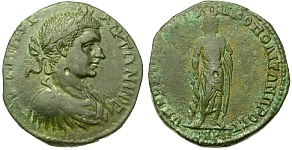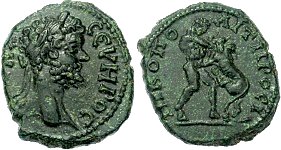Fine Coins Showcase
Antiquities Showcase
Show Empty Categories
Shop Search
Shopping Cart
My FORVM
Contact Us
About Forum
Shopping at Forum
Our Guarantee
Payment Options
Shipping Options & Fees
Privacy & Security
Forum Staff
Selling Your Coins
Identifying Your Coin
FAQs
zoom.asp
Home ▸ Catalog ▸ |Greek Coins| ▸ |Geographic - All Periods| ▸ |Thrace & Moesia| ▸ |Nikopolis||View Options:   | | | | | | Nicopolis ad Istrum was founded by Trajan around 101-106, at the junction of the Iatrus (Yantra) and the Rositsa rivers, in memory of his victory over the Dacians. Its ruins are located at the village of Nikyup, 20 km north of Veliko Tarnovo in northern Bulgaria. The town peaked during the reigns of Trajan, Hadrian, the Antonines and the Severan dynasty. In 447, the Nicopolis was destroyed by Attila's Huns. In the 6th century, it was rebuilt as a powerful fortress enclosing little more than military buildings and churches, following a very common trend for the cities of that century in the Danube area. It was finally destroyed by the Avar invasions at the end of the 6th century. |


Asclepius learned the secrets of healing after seeing one snake bring another herbs. Woman seeking fertility, and the sick and injured, slept in his temples where snakes were left to crawl on the floor and provide healing. Nearby excavations found 2nd c. bronze surgical instruments and a case containing a variety of medicines.RP29741. Bronze AE 26, Varbanov I 3978a, EF, superb portrait, upper reverse flat, weight 11.319 g, maximum diameter 26.1 mm, die axis 180o, Nicopolis ad Istrum (Nikyup, Bulgaria) mint, cos. legate Ti. Flavius Novius Rufus, 218 - 222; obverse AVT K AVPH ANTΩNEINOC, laureate, draped, and cuirassed bust right; reverse YΠ NOBIOY POYΦOY NIKOΠOΛITΩN ΠΠOC ICTPON, Asklepios standing facing, head left, resting right hand on snake-entwined staff, left hand on hip; SOLD
Septimius Severus, 9 April 193 - 4 February 211 A.D., Nikopolis ad Istrum, Moesia Inferior


The first of Herakles' twelve labors, set by his cousin King Eurystheus, was to slay the Nemean lion and bring back its skin. It could not be killed with mortal weapons because its golden fur was impervious to attack. Its claws were sharper than swords and could cut through any armor. Herakles stunned the beast with his club and, using his immense strength, strangled it to death. During the fight, the lion bit off one of his fingers. After slaying the lion, he tried to skin it with a knife but failed. Wise Athena, noticing the hero's plight, told him to use one of the lion's own claws to skin the pelt.SH68062. Bronze assarion, Varbanov I 2347; H-H-J Nikopolis p. 83, 8.14.14.24 corr. (same dies, R2); cf. AMNG I/I 1390 (obverse) and 1389 (reverse), EF, sharp, beautiful patina, weight 4.220 g, maximum diameter 17.2 mm, die axis 225o, Nicopolis ad Istrum (Nikyup, Bulgaria) mint, obverse AV K Λ C CEVHPOC Π, laureate head right; reverse NIKOΠOΛIT ΠPOC I, Herakles standing right, wrestling with the Nemean lion; SOLD
Septimius Severus, 9 April 193 - 4 February 211 A.D., Nikopolis ad Istrum, Moesia Inferior


The first of Herakles' twelve labors, set by his cousin King Eurystheus, was to slay the Nemean lion and bring back its skin. It could not be killed with mortal weapons because its golden fur was impervious to attack. Its claws were sharper than swords and could cut through any armor. Herakles stunned the beast with his club and, using his immense strength, strangled it to death. During the fight, the lion bit off one of his fingers. After slaying the lion, he tried to skin it with a knife but failed. Wise Athena, noticing the hero's plight, told him to use one of the lion's own claws to skin the pelt.SH54579. Bronze pentassarion, H-H-J Nikopolis 8.14.14.3 (same dies); Varbanov I 2761, AMNG I/I -, gVF, weight 11.552 g, maximum diameter 28.4 mm, die axis 225o, Nicopolis ad Istrum (Nikyup, Bulgaria) mint, consular legate Ovinius Tertullus, 198 - 201 A.D.; obverse AV K Λ CE CEVHPOC Π, laureate head right; reverse VΠA OOVI TEPTVΛΛOV NIKOΠO ΠPOC I, Hercules standing half right, resting on club set on a rock at feet right, right hand behind back, nude but for Nemean lion skin over left shoulder; some cleaning scratches, attractive green patina; SOLD
Macrinus, 11 April 217 - 8 June 218 A.D., Nikopolis ad Istrum, Moesia Inferior


Nicopolis ad Istrum was founded by Trajan around 101-106, at the junction of the Iatrus (Yantra) and the Rositsa rivers, in memory of his victory over the Dacians. Its ruins are located at the village of Nikyup, 20 km north of Veliko Tarnovo in northern Bulgaria. The town peaked during the reigns of Trajan, Hadrian, the Antonines and the Severan dynasty. In 447, the Nicopolis was destroyed by Attila's Huns. In the 6th century, it was rebuilt as a powerful fortress enclosing little more than military buildings and churches, following a very common trend for the cities of that century in the Danube area. It was finally destroyed by the Avar invasions at the end of the 6th century. The reverse legend refers to Consular Legate (Governor) Marcus Claudius Agrippa.RP88337. Bronze AE 26, H-H-J Nikopolis 8.23.46.4 (R4), Varbanov I 3383 (R5), Moushmov 1234, VF, dark patina, edge crack, light deposits, weight 11.625 g, maximum diameter 25.6 mm, die axis 225o, Nicopolis ad Istrum (Nikyup, Bulgaria) mint, consular legate Marcus Agrippa, 217 - 218 A.D.; obverse AY K OΠΠEΛ CEYH MAKPINOC, laureate head right; reverse YΠ AΓPIΠΠA NIKOΠOΛITΩN ΠPOC ICTPΩ, city gate with three crenelated towers and closed paneled doors; ex Forum (2009), ex Zach Beasley architectural theme collection (2001), ex Malter Galleries; SOLD
Diadumenian, Mid May - 8 June 218 A.D., Nikopolis ad Istrum, Moesia Inferior


Unpublished in the major references. Extremely rare and possibly unique.SH07676. Bronze AE 28, H-H-J Nikopolis 8.25.6.1 (R4), Moushmov 1353, BMC Thrace -, Lindgren -, AMNG I/I -, SNG Cop -, SGICV -, Choice gVF, weight 11.34 g, maximum diameter 28.1 mm, die axis 0o, Nicopolis ad Istrum (Nikyup, Bulgaria) mint, as caesar, May 217 - mid May 218 A.D.; obverse M OΠEΛΛI ΔIAΔOYMENIANOC KAI, draped and cuirassed bust right; reverse YΠ CTA ΛONΓINOY NIKOΠOΛITΩN ΠPOCIC, Serapis standing left, turreted, holding branch in right and transverse scepter in left; magistrate Statius Longinus, superb portrait, extremely rare, from the Scott Collection; SOLD
Elagabalus, 16 May 218 - 11 March 222 A.D., Nikopolis ad Istrum, Moesia Inferior


Nicopolis ad Istrum can be said to have been the birthplace of Germanic literary tradition. The Gothic bishop, missionary and translator Ulfilas (Wulfila) obtained permission from Constantius II to immigrate with his flock of converts to Moesia and settle near Nicopolis ad Istrum in 347. There, he invented the Gothic alphabet and translated the Bible from Greek to Gothic.SH60004. Bronze AE 21, H-H-J Nikopolis 8.26.46.8, Varbanov I 3830, AMNG I/I 2017 var. (obv. legend), aEF, weight 5.811 g, maximum diameter 21.1 mm, die axis 0o, Nicopolis ad Istrum (Nikyup, Bulgaria) mint, obverse AVT K M AVPH ANTΩNINOC, laureate and cuirassed bust right; reverse NIKOΠOΛITΩN ΠPOC I, CTPON in ex, City gate flanked by two towers; rare; SOLD
Septimius Severus, 9 April 193 - 4 February 211 A.D., Nikopolis ad Istrum, Moesia Inferior


In Greek mythology, Priapus was a minor rustic fertility god, protector of livestock, fruit plants, gardens and male genitalia. Priapus is marked by his oversized, permanent erection, which gave rise to the medical term priapism. He became a popular figure in Roman erotic art and Latin literature, and is the subject of the often humorously obscene collection of verse called the Priapeia.SH77305. Bronze AE 18, H-H-J Nikopolis 8.14.17.4 (R5), AMNG I/I 1380, Moushmov 988, Varbanov I 2530 (R3), VF, well centered, green patina, flan cracks, weight 2.895 g, maximum diameter 18.2 mm, die axis 225o, Nicopolis ad Istrum (Nikyup, Bulgaria) mint, 9 April 193 - 4 February 211 A.D.; obverse AV KAI CEΠ CEVHPOC, laureate head right; reverse NIKOΠOΛI-TΩN ΠPOC IC, Priapus standing half left with enormous phallus; SOLD
Caracalla, 28 January 198 - 8 April 217 A.D., Nikopolis ad Istrum, Moesia Inferior


Nicopolis ad Istrum was founded by Trajan around 101 - 106, at the junction of the Iatrus (Yantra) and the Rositsa rivers, in memory of his victory over the Dacians. Its ruins are located at the village of Nikyup, 20 km north of Veliko Tarnovo in northern Bulgaria. The town reached its peak during the reigns of Trajan, Hadrian, the Antonines and the Severan dynasty.SH53793. Bronze AE 27, H-H-J Nikopolis 8.18.32.1 (R4), Varbanov I 3101 (R3), AMNG I/I 1526, Moushmov 1122, VF, attractive style, nice green patina with a few not too distracting chips, weight 15.802 g, maximum diameter 27.3 mm, die axis 255o, Nicopolis ad Istrum (Nikyup, Bulgaria) mint, consular legate Ovinius Tertullus, 198 - 201 A.D.; obverse AV K M AVP - ANTΩNINOC, laureate, draped, and cuirassed bust right, seen from behind; reverse YΠ A OOY TEPTYAΛ ΛOY NIKOΠOΛIT / ΠPOCI, River god reclining left, holding grain and poppy in right, reeds in left, left elbow resting on ground, water flowing below him; vary rare variety; SOLD
Elagabalus, 16 May 218 - 11 March 222 A.D., Nikopolis ad Istrum, Moesia Inferior


In Greek mythology, Priapus was a minor rustic fertility god, protector of livestock, fruit plants, gardens and male genitalia. Priapus is marked by his oversized, permanent erection, which gave rise to the medical term priapism. He became a popular figure in Roman erotic art and Latin literature, and is the subject of the often humorously obscene collection of verse called the Priapeia.RP97814. Bronze AE 18, H-H-J Nicopolis 8.26.17.4 (R6), AMNG I/I 2023, Varbanov I 3862 (R6) corr. (AVT K M...), Moushmov 1439, SNG Cop -, BMC Thrace -, gVF, nice dark green patina, off center, weight 2.891 g, maximum diameter 18.1 mm, Nicopolis ad Istrum (Nikyup, Bulgaria) mint, 16 May 218 - 11 Mar 222 A.D.; obverse AVT M AVP ANTΩNINOC, laureate head right; reverse NIKOΠOΛI-TΩN ΠPOCT, Priapus standing half left, patera in right hand, with his left hand supporting a bowl of fruit balanced on his enormous phallus, PON in exergue; ex Roma Numismatics e-sale 76 (7 Nov 2020), lot 727; ex collection of Z.P. (Austria); this is the first specimen of this type handled by FORVM; scarce; SOLD
Septimius Severus, 9 April 193 - 4 February 211 A.D., Nikopolis ad Istrum, Moesia Inferior


Plate coin for The coins of Moesia Inferior 1st - 3rd c. A.D., Nicopolis ad Istrum by N. Hristova, H.-J. Hoeft, and G. Jekov.
Nicopolis ad Istrum was founded by Trajan around 101 - 106, at the junction of the Iatrus (Yantra) and the Rositsa rivers, in memory of his victory over the Dacians. Its ruins are located at the village of Nikyup, 20 km north of Veliko Tarnovo in northern Bulgaria. The town reached its peak during the reigns of Trajan, Hadrian, the Antonines and the Severan dynasty.
Minted under the consular legate (governor) Aurelius GallusSH63865. Aes AE 25, H-H-J Nikopolis 8.14.38.10 (this coin); cf. AMNG I/I 1318 ff., Varbanov I 2709, gVF, struck with a repaired reverse die, scratches, weight 11.691 g, maximum diameter 25.4 mm, die axis 180o, Nicopolis ad Istrum (Nikyup, Bulgaria) mint, consular legate Aurelius Gallus, 201 - 203 A.D.; obverse AY K Λ C CEYHPOC ΠEP, laureate head right; reverse YΠ AYP ΓAΛΛO-Y NIKOΠOΛITΩ / ΠPOC ICT, Tyche standing slightly left, head left, kalathos on head, rudder on globe in right hand, cornucopia in left; ex Gorny & Mosch auction 160 (Oct 2007), lot 1793; SOLD

You are viewing a SOLD items page.
Click here to return to the page with AVAILABLE items.
The sale price for a sold item is the private information of the buyer and will not be provided.



REFERENCES
Page created in 1.406 seconds.






